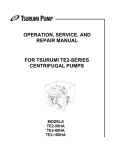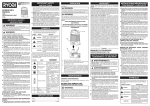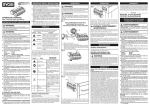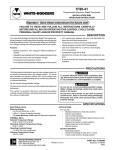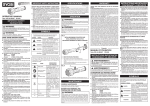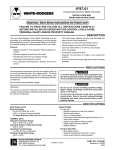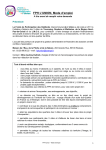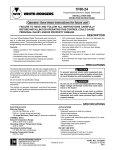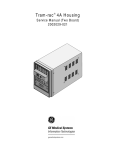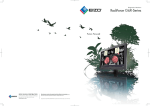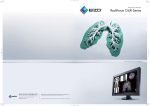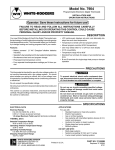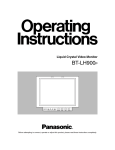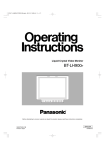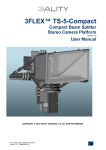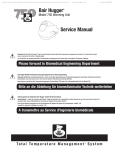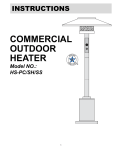Download operation, service, and repair manual for tsurumi ept3
Transcript
OPERATION, SERVICE, AND REPAIR MANUAL FOR TSURUMI EPT3-SERIES TRASH PUMPS MODELS EPT3-50HA EPT3-80HA EPT3-100HA LIMITED WARRANTY TSURUMI MANUFACTURING CO., LTD. (“TSURUMI”) warrants to the original end purchaser during the warranty period, every new TSURUMI pump or product to be free from defects in material and workmanship under normal use and service, when properly installed, used, and maintained (in accordance with Tsurumi’s Operation, Service, and Repair Manual) for a period of two years from the date the unit was first installed or twenty six months from the date of shipment by TSURUMI to wholesaler, whichever comes first. TSURUMI’S sole obligation under this warranty is to repair or replace at TSURUMI’S option, with new or remanufactured parts, any part(s) that fail or that are found to be defective during the warranty period. No allowance will be made for shipping charges, damages, labor, or other charges due to failure, repair or replacement. This warranty does not apply to any TSURUMI product that has been disassembled without prior approval of TSURUMI nor does it apply to any product that has been subjected to misuse, neglect, alteration, misapplication, accident or act of God. TSURUMI assumes no responsibility for compliance with any regulations, codes, standards, or ordinances applicable to the installation, location, operation or maintenance of its products. No other warranty, expressed or implied, is authorized by, or applicable to, the seller. No person, agent or dealer is authorized to enlarge upon this warranty. TSURUMI expressly disclaims liability for consequential or incidental damages or breach of expressed or implied warranty; and any implied warrant of fitness for a particular purpose and merchantability shall be limited to the duration of the expressed warranty. Some states do not allow limitations on the duration of an implied warranty, so the above limitation or exclusion may not apply to you. Some states do not allow the exclusion or limitation of incidental or consequential damages, so the above limitation of exclusion may not apply to you. This warranty gives you specific legal rights and you may also have other rights, which vary from state to state. Tsurumi Manufacturing Co., Ltd. TABLE OF CONTENTS Section/Title 1. Introduction . . . . . . . . . . . . . . . . . . . . . . . . . . . . . . . . . . . . . . . . . . . . . . . . . . . . . . . 1-1. Using Your Tsurumi Operation, Repair and Service Manual . . . . . . . . . . . . . . . . . . . 1-2. Precautions . . . . . . . . . . . . . . . . . . . . . . . . . . . . . . . . . . . . . . . . . . . . . . . . . . . . . . 1-3. Safety Precautions . . . . . . . . . . . . . . . . . . . . . . . . . . . . . . . . . . . . . . . . . . . . . . . . . 1-4. Specifications / Key Features . . . . . . . . . . . . . . . . . . . . . . . . . . . . . . . . . . . . . . . . . . 1-5. Performance Curves . . . . . . . . . . . . . . . . . . . . . . . . . . . . . . . . . . . . . . . . . . . . . . . . 2. Operating Instructions . . . . . . . . . . . . . . . . . . . . . . . . . . . . . . . . . . . . . . . . . . . . . . . 2-1. Operating Controls . . . . . . . . . . . . . . . . . . . . . . . . . . . . . . . . . . . . . . . . . . . . . . . . . 2-2. Check the Engine Oil Level . . . . . . . . . . . . . . . . . . . . . . . . . . . . . . . . . . . . . . . . . . . 2-3. Check Engine Fuel . . . . . . . . . . . . . . . . . . . . . . . . . . . . . . . . . . . . . . . . . . . . . . . . . 2-4. Check Fuel Level . . . . . . . . . . . . . . . . . . . . . . . . . . . . . . . . . . . . . . . . . . . . . . . . . . 2-5. Pre-Start Checks . . . . . . . . . . . . . . . . . . . . . . . . . . . . . . . . . . . . . . . . . . . . . . . . . . 2-6. Starting and Operating the Engine . . . . . . . . . . . . . . . . . . . . . . . . . . . . . . . . . . . . . . 2-7. Using the Trash Pump . . . . . . . . . . . . . . . . . . . . . . . . . . . . . . . . . . . . . . . . . . . . . . 2-8. Stopping the Trash Pump . . . . . . . . . . . . . . . . . . . . . . . . . . . . . . . . . . . . . . . . . . . . 2-9. Oil Alert . . . . . . . . . . . . . . . . . . . . . . . . . . . . . . . . . . . . . . . . . . . . . . . . . . . . . . . . . 3. Troubleshooting . . . . . . . . . . . . . . . . . . . . . . . . . . . . . . . . . . . . . . . . . . . . . . . . . . . 3-1. Troubleshooting Charts . . . . . . . . . . . . . . . . . . . . . . . . . . . . . . . . . . . . . . . . . . . . . . 4. Maintenance . . . . . . . . . . . . . . . . . . . . . . . . . . . . . . . . . . . . . . . . . . . . . . . . . . . . . . 4-1. Maintenance Schedule . . . . . . . . . . . . . . . . . . . . . . . . . . . . . . . . . . . . . . . . . . . . . . . 4-2. Changing Engine Oil . . . . . . . . . . . . . . . . . . . . . . . . . . . . . . . . . . . . . . . . . . . . . . . . 4-3. Air Cleaner Service . . . . . . . . . . . . . . . . . . . . . . . . . . . . . . . . . . . . . . . . . . . . . . . . . 4-4. Sediment Cup Cleaning . . . . . . . . . . . . . . . . . . . . . . . . . . . . . . . . . . . . . . . . . . . . . 4-5. Cleaning and Adjusting Spark Plug . . . . . . . . . . . . . . . . . . . . . . . . . . . . . . . . . . . . . 4-6. Trash Pump Exploded Views . . . . . . . . . . . . . . . . . . . . . . . . . . . . . . . . . . . . . . . . . 4-7. Description of Mechanical Seal . . . . . . . . . . . . . . . . . . . . . . . . . . . . . . . . . . . . . . . . 4-8. Replacement of Mechanical Seal . . . . . . . . . . . . . . . . . . . . . . . . . . . . . . . . . . . . . . . 4-9. Replacing of Check Valve . . . . . . . . . . . . . . . . . . . . . . . . . . . . . . . . . . . . . . . . . . . . 5. Storage Instructions . . . . . . . . . . . . . . . . . . . . . . . . . . . . . . . . . . . . . . . . . . . . . . . . . 5-1. Procedures for Storing Pump . . . . . . . . . . . . . . . . . . . . . . . . . . . . . . . . . . . . . . . . . . 6. Replacement Parts . . . . . . . . . . . . . . . . . . . . . . . . . . . . . . . . . . . . . . . . . . . . . . . . . 6-1. Introduction . . . . . . . . . . . . . . . . . . . . . . . . . . . . . . . . . . . . . . . . . . . . . . . . . . . . . . . 6-2. Ordering Parts . . . . . . . . . . . . . . . . . . . . . . . . . . . . . . . . . . . . . . . . . . . . . . . . . . . . . Appendix A - Wheel Kit Model PGWK-200 . . . . . . . . . . . . . . . . . . . . . . . . . . . . . . . . . . . . . . Page 1 1 1 2 3 3 6 6 6 8 8 9 9 10 10 10 11 11 12 12 13 14 14 14 15 15 15 20 22 22 23 23 23 A-1 Tsurumi’s Operation, Service, and Repair Manual INTRODUCTION 1-1 Using Your Tsurumi Operation, Repair and Service Manual We thank you for purchasing a Tsurumi trash pump. We are sure that the trash pump you have selected will meet your portable pumping needs. This manual applies to the Tsurumi trash pumps listed below. Specifications for the trash pumps are provided in the SPECIFICATIONS section. Key features of the trash pump are shown in the DESCRIPTION section. EPT3-50HA EPT3-80HA EPT3-100HA This manual provides instructions for operation, service, and repair of your trash pump. We strongly recommend that those who operate the trash pump become familiar with the trash pump’s features and controls, and read the operating instructions before using the trash pump. The Operation, Repair, and Service Manual also provides instructions to service, checkout, and repair the trash pump. This manual also provides replacement parts information. Repair and service information for the Honda engine is provided in the Owner’s Manual for Models GX160, GX240, and GX340. A copy of the Owner’s Manual has been provided in the trash pump’s literature package. Parts information for the Honda Engine is available in Honda’s Parts Catalogs. When there are differences between trash pump models, separate instructions are provided. The separate instructions are provided to make sure the correct procedures are used on the affected trash pumps. All information in the Tsurumi manuals is based upon the latest production configuration of the trash pump at the time of approval for printing. If you have a problem with your trash pump that cannot be resolved using the Operation, Repair, and Service Manual, or if you have questions about the operation, service, repair, or maintenance of your trash pump, contact your local Tsurumi trash pump dealer. 1-2 Precautions Pay special attention to precautionary notes preceded by the words WARNING, CAUTION, and NOTE. WARNINGS indicate that there is a strong possibility of personal injury or loss of life if the procedure is not followed, or if cleaning, lubricating, adhesives, and other materials are not used properly. CAUTIONS indicate that there is a possibility of equipment damage if instructions are not followed. NOTES are used in procedures to provide additional or supplemental information to make the procedure easier or more efficient. WARNING: • The trash pump is designed to give safe and dependable service when operated according to the instructions in the technical manual provided with the trash pump. • Do not operate the trash pump before you have read and understand the instructions and the engine manufacturer’s manual. Failure to do so could result in personal injury or equipment damage. Introduction Page 1 Tsurumi’s Operation, Service, and Repair Manual 1-3 Safety Precautions WARNING: • IN ORDER TO ASSURE SAFE AND EFFICIENT OPERATION OF THE TRASH PUMP, OPERATOR’S SHOULD READ AND COMPLY WITH THE FOLLOWING SAFETY PRECAUTIONS. • Do not operate the trash pump near gasoline or gaseous fuels because of the potential danger from explosion or fire. • Do not fill the fuel tank with fuel while the engine is running. Be careful not to spill fuel during refueling. If fuel is spilled, wipe it off and let it dry before starting the engine. • Do not smoke or use open flame near the fuel tank. • Do not place flammable materials near the trash pump. Be careful not to place fuel, matches, gunpowder, oily cloths, straw, trash, or any other combustibles near the trash pump. • Do not operate the trash pump inside a room, cave, tunnel, or other insufficiently ventilated area. Always operate the trash pump in a well-ventilated area. The engine may become overheated, and the poisonous carbon monoxide gas contained in the exhaust gases will endanger human lives. • Keep the trash pump at least 1 meter (3 feet) away from any structure or building during use. When a trash pump is located close to a building or nearby equipment, heat and exhaust from the engine will cause the surrounding temperature to rise. This will degrade the engines cooling efficiency, causing overheating. • Do not enclose the trash pump nor cover it with a box. The trash pump has a built-in, forcedair cooling system, and may become overheated if it is enclosed. • Operate the trash pump on a level surface. It is not necessary to prepare a special foundation for the trash pump. However, the trash pump will vibrate on an irregular surface. Therefore, choose a level place without surface irregularities. • Shutoff the trash pump when moving the trash pump to another work site. It the trash pump is tilted or moved during operation, fuel may spill and/or the trash pump may tip over, causing a hazardous situation. Proper lubrication cannot be expected if the trash pump is operated on a steep incline or slope. In such a case, the piston may seize; it may seize even if the oil is above the upper level. Page 2 Introduction Tsurumi’s Operation, Service, and Repair Manual 1-4 Specifications / Key Features • Heavy-duty Honda Engine— proven reliability—quiet operation—efficient fuel consumption • Oil Level Sensor—prevents engine operation when oil level is low • New Design Clean Out Cover— cover removes quickly for clean-out without the need to remove the suction hose • New Design—larger pump casing for increased durability • Mechanical Seal—silicon carbide seal element for long life • Rubber Vibration Isolation Mounts—isolates pump/engine vibration from the frame for maximum protection and noise reduction. • Durable Rolled Steel Frame—for strength and durability • High Chrome Impeller—increase ability to withstand the impact of debris passing through the pump • Cast Iron Volute Casing/Stainless Steel Wear Plate/Galvanized Steel Hose Couplings. PUMP MODELS Pump Output Gal./Min-to-Total Head EPT3-100HA See Performance Curve Inches 2 NPT Male 3 NPT Male 4 NPT Male Discharge Size Inches 2 3 4 GX160K1VED2 GX240K1VED2 GX340K1ED6 5.5 (3600 rpm) 8.0 (3600 rpm) 11.0 (3600 rpm) 163 (10) 242 (15) 337 (21) 0.95 1.6 1.7 64 dB 68 dB 72 dB ---- Max. HP (rpm) ENGINE EPT3-80HA See Performance Curve Suction Size Engine Models (Honda) SET EPT3-50HA See Performance Curve hp/rpm 3 Displacement CC (In ) Fuel Tank Capacity Gals. Noise Level (Rated Load) dB Starting System --- Dimensions (L x W x H) Shipping Weight Recoil Inches 23 Lbs. 82 x 18 x 17 Recoil Recoil 27 30 _ x 20 x 20 _ x 25 136 x 26 160 1-5 Performance Curves Refer to the performance curves for the pumping capacity of NPT3 series trash pumps. GROUP PERFORMANCE MODELS EPT3-50HA EPT3-80HA EPT3-100HA TOTAL HEAD(ft.) 100 EPT3-80HA 80 EPT3-100HA 60 40 20 EPT3-50HA 0 0 100 200 300 400 500 600 QUANTITY(g.p.m.) Introduction Page 3 Tsurumi’s Operation, Service, and Repair Manual 100 INDIVIDUAL PERFORMANCE MODEL EPT3-50HA TOTAL HEAD(ft.) 80 60 MODEL EPT3-50HA 40 20 0 0 100 200 300 400 500 600 QUANTITY(g.p.m.) 100 INDIVIDUAL PERFORMANCE MODEL EPT3-80HA TOTAL HEAD(ft.) 80 60 MODEL EPT3-80HA 40 20 0 0 100 200 300 400 500 600 400 500 600 QUANTITY(g.p.m.) 100 INDIVIDUAL PERFORMANCE MODEL EPT3-100HA TOTAL HEAD(ft.) 80 60 40 MODEL EPT3-100HA 20 0 0 100 200 300 QUANTITY(g.p.m.) Page 4 Introduction Tsurumi’s Operation, Service, and Repair Manual Engine Air Filter Priming Plug Discharge Fitting Engine Muffler Suction Fitting Vibration Isolation Mounts Casing Cover Clamping Knobs PUMP END Fuel Tank Tubular Frame Honda Engine Recoil Starter Engine Controls ENGINE END Figure 1: Key Features of the Trash Pump Introduction Page 5 Tsurumi’s Operation, Service, and Repair Manual OPERATING INSTRUCTIONS 2-1 Operating Controls A. The trash pump operating controls are located on the engine. B. The controls consist of a throttle lever (for speed control), choke lever (for cold weather starting), fuel shutoff lever (to prevent fuel spills), and a recoil starter (to turnover engine by hand). (Refer to Figure 2-1.) Throttle Lever Choke Lever OFF ON Fuel Shutoff Valve ON/OFF Switch Recoil Starter Hand Grip (Located on Recoil Starter Shroud) Figure 2-1: Operating Controls 2-2 Check the Engine Oil Level CAUTION: • ENGINE OIL IS A MAJOR FACTOR AFFECTING PERFORMANCE AND SERVICE LIFE. NON-DETERGENT OILS AND 2-STROKE OILS ARE NOT RECOMMENDED BECAUSE THEY HAVE INADEQUATE LUBRICATING CHARACTERISTICS • CHECK THE OIL LEVEL WITH THE ENGINE ON A LEVEL SURFACE AND THE ENGINE STOPPED. A. The trash pump is controlled by the engine operating controls. B. Use Honda 4-stroke oil, or use an equivalent high detergent, premium quality motor oil certified to meet or exceed U.S. automobile manufacturer’s requirements for Service Classification SG, SF. Motor oils classified SG, SF will show this designation on the container. SAE 10W/30 is recommended for general, all-temperature use. C. Other viscosity grades shown in Figure 2-2 may be used when the average temperature in your area is within the indicated range. Page 6 Operating Instructions Tsurumi’s Operation, Service, and Repair Manual Figure 2-2: Oil Viscosity Grade-to-Temperature Recommendations D. When checking oil, observe the following (refer to Figure 2-3): (Make sure the engine is in a level position.) (1) (2) Remove the oil filler cap/dipstick and wipe it clean. Insert the filler cap/dipstick into the oil filler neck, but do not screw it in. (3) Remove the filler cap/dipstick and check the oil level. (4) If the level is low, fill to the top of the oil filler neck with the recommended oil. (5) Reinstall the oil filler cap/dipstick. Operating Instructions Page 7 Tsurumi’s Operation, Service, and Repair Manual 2-3 Check Engine Fuel WARNING • MAKE SURE YOU REVIEW EACH WARNING IN ORDER TO PREVENT FIRE HAZARD. • DO NOT REFILL TANK WHILE ENGINE IS RUNNING OR HOT. • CLOSE FUEL SHUT OFF VALVE BEFORE REFUELING WITH FUEL. • BE CAREFUL NOT TO GET DUST, DIRT, WATER OR OTHER FOREIGN OBJECTS INTO FUEL. • WIPE OFF SPILLED FUEL THOROUGHLY BEFORE STARTING ENGINE. • KEEP AWAY FROM OPEN FLAMES. • DO NOT USE SMOKING MATERIALS WHEN FILLING THE FUEL TANK. • DO NOT REFUEL WHILE SMOKING OR NEAR OPEN FLAME OR OTHER SUCH POTENTIAL FIRE HAZARDS. OTHERWISE FIRE ACCIDENT MAY OCCUR. • AVOID REPEATED OR PROLONGED CONTACT WITH SKIN OR BREATHING OF VAPOR. • KEEP OUT OF REACH OF CHILDREN. 2-4 Check Fuel Level A. If fuel level is low, refill with unleaded automotive gasoline. B. Fuel tank capacities are provided below: EPT3-50HA . . . . . . . . . . . . . . . .0.95 gal. EPT3-80HA . . . . . . . . . . . . . . . .1.60 gal. EPT3-100HA . . . . . . . . . . . . . . .1.70 gal. Page 8 Operating Instructions Tsurumi’s Operation, Service, and Repair Manual 2-5 Pre-Start Checks WARNING: • MAKE SURE YOU REVIEW EACH WARNING IN ORDER TO PREVENT FIRE HAZARD. • KEEP AREA CLEAR OF FLAMMABLES OR OTHER HAZARDOUS MATERIALS. A. Check the following items before starting the engine. (1) Fuel leakage from (fuel hose, sediment cup, etc.). (2) Bolts and nuts for looseness. (3) Components for damage or breakage. (4) Check trash pump surroundings. (a) Keep trash pump at least three (3) feet (one [1] meter) away from buildings or other structures. (b) Only operate trash pump in a dry, well-ventilated area. (c) Keep exhaust pipe clear of foreign objects. (d) Keep trash pump away from open flame. (e) Keep trash pump on a stable and level surface. (f) Do not block trash pump air vents with paper or other material. 2-6 Starting and Operating the Engine A. Refer to the Honda engine owner’s manual. B. Put the fuel valve in the ON position. C. Move the choke lever to the closed position. Operating Instructions Page 9 Tsurumi’s Operation, Service, and Repair Manual NOTE: • The choke may not be needed if the engine is warm or the air temperature is high. D. Set the ON/OFF switch to ON (the ON/OFF switch is mounted on the recoil shroud). E. Move the throttle lever slightly to the left. F. Pull the starter grip lightly until resistance is felt, then pull briskly. NOTE: • Do not allow the starter grip to snap back against the engine. Return it gently to prevent damage to the starter. G. As the engine warms up, gradually move the choke lever to the OPEN position. 2-7 Using The Trash Pump A. Connect suction and discharge hoses. Make sure suction hose is fitted with a strainer. B. Remove priming plug from top of pump and fill chamber with water. C. Operate the engine at idle speed for 3 to 5 minutes. D. After engine warm up, move the throttle lever to the operating speed. 2-8 Stopping The Trash Pump A. Move the throttle lever fully to the right. B. Set the ON/OFF switch to OFF. C. Turn the fuel valve to the OFF position. 2-9 Oil Alert A. Page 10 The oil alert sensor detects the lowering of the oil level in the crankcase and automatically stops the engine when the oil level falls below the predetermined level. (1) When the engine stops automatically, check the oil level. Refill engine oil to the upper level and restart the engine. (2) If the engine does not start by usual starting procedures, check the oil level. Operating Instructions Tsurumi’s Operation, Service, and Repair Manual TROUBLESHOOTING The troubleshooting tables below can be used as a guide to isolate trash pump faults. Refer to these tables when the engine fails to start after several attempts. If, after following these procedures, the pump fails to start, contact the nearest Tsurumi generator dealer. Table 3-1: Troubleshooting Table Fault Pump does not pump. Discharge flow or pump pressure too low. Probable Cause Remedy Insufficient priming water. Add more water through priming plug. Mechanical seal chipped or broken. Replace mechanical seal. Check valve damaged. Replace check valve. Suction hose damaged or strainer clogged. Replace hose. Clean strainer. Air leaks caused by O-ring damage. Replace O-rings. Air leaks caused by O-ring damage. Replace O-rings. Suction hose or strainer clogged. Replace hose. Clean strainer. Pump primes too slowly. Excessive impeller clearance. Disassemble to obtain casing cover and impeller. Determine clearance and reshim as required (refer to Replacement of Mechanical Seal). Engine rpm too low. Check rpm and reset throttle as required. Lift head too high. Lower lift head. Insufficient priming water. Add more water through priming plug. Mechanical seal chipped or broken. Replace mechanical seal. Check valve damaged. Replace check valve. Suction hose damaged or strainer clogged. Replace hose. Clean strainer. Noise or vibration. Air leaks caused by O-ring damage. Replace O-rings. Engine rpm too low. Check rpm and reset throttle as required. Lift head too high. Lower lift head. Faulty mounting. Pump/engine attaching parts loose. Tighten as required. Damaged vibration isolation mounts. Replace mounts. Troubleshooting Page 11 Tsurumi’s Operation, Service, and Repair Manual MAINTENANCE 4-1 Maintenance Schedule To maintain the trash pump in peak operating condition, observe and implement the maintenance and adjustment schedule in Table 4-1. Inspect and/or service the trash pump at the intervals shown in Table 4-1. WARNING: • SHUT OFF THE ENGINE BEFORE PERFORMING ANY MAINTENANCE. IF OPERATION OF THE ENGINE IS REQUIRED, MAKE SURE THE AREA IS WELL VENTILATED; THE ENGINE EXHAUST CONTAINS POISONOUS CARBON MONOXIDE GAS. CAUTION: • REFER TO THE HONDA ENGINE OWNER’S MANUAL FOR OTHER MAINTENANCE REQUIREMENTS. Table 4-1: Maintenance Schedule Frequency Daily Maintenance Action Check oil level. Check all components according to the PRE-OPERATIONAL CHECKS section. 50 Hours Wash cleaner element. Check spark plug and clean if necessary. 100 Hours Change engine oil. 200 Hours Adjust spark plug gap. Clean fuel strainer. 500 Hours (12 Months) Replace spark plug and cleaner element. Clean and adjust carburetor, valve clearance, and valve seat along with cylinder head. 1,000 Hours (24 Months) Check rotor and stator. Replace engine isolation mounts. Overhaul engine. Change fuel lines. Page 12 Maintenance Tsurumi’s Operation, Service, and Repair Manual 4-2 Changing Engine Oil A. An initial oil change should be performed after the first twenty- (20) hours of use. Thereafter, change oil every 100 hours. B. Before changing the oil, check for a suitable way to dispose of the used oil. Do not pour it down sewer drains, onto garden soil or into open streams. Refer to your local zoning and environmental regulations for disposal and handling requirements. C. Drain the oil while the engine is still warm to assure rapid and complete draining. D. Remove the oil filler dipstick/cap and drain plug. Allow oil to drain from the engine (refer to Figure 4-1). Figure 4-1: Draining Engine Oil E. Install the drain plug, and tighten it securely. F. Refill with the recommended oil (refer to Figure 2-2). G. After filling with oil, check the oil level. H. When oil reaches the upper limit, install the oil filler dipstick/cap (Figure 4-2). NOTE: • Engine oil capacity: 1.1 liters (1.16 U.S. Quart) Figure 4-2: Checking Oil Level Maintenance Page 13 Tsurumi’s Operation, Service, and Repair Manual 4-3 Air Cleaner Service WARNING • Never use gasoline or low flash point solvents for cleaning the air cleaner element. A fire or explosion could result. A dirty air cleaner will restrict airflow to the carburetor. To prevent degraded engine operation, service the air cleaner regularly. Service more frequently when operating the engine in extremely dusty areas. NOTE: • Never run the engine without the air cleaner. Rapid engine wear will result from contaminants, such as dust and dirt, being drawn through the carburetor and into the engine. 4-4 Sediment Cup Cleaning WARNING: • Gasoline is extremely flammable and is explosive under certain conditions. Do not smoke or allow open flames or sparks in the area. A. Turn the fuel valve to OFF (refer to Figure 2-1). B. Remove the sediment cup and O-ring. Wash both parts in nonflammable or high flash point solvent. C. Wipe the sediment cup and O-ring dry, then reinstall. WARNING: • After installing the sediment cup, check for leaks, and make sure the area is free of residual fuel spills or seepage before starting the engine. D. Set the fuel shutoff valve (Figure 2-1) to ON. Check for leaks. 4-5 Cleaning and Adjusting Spark Plug Recommended spark plugs: BPR6ES (NGK) W20EPR-U (NIPPONDENSO) A. To ensure proper engine operation, the spark plug must be properly gapped and free of deposits. B. Remove the spark plug cap. C. Clean any dirt from around the spark plug base. D. Use the proper size spark plug wrench to remove the spark plug. WARNING • THE MUFFLER BECOMES VERY HOT DURING OPERATION AND REMAINS HOT FOR A WHILE AFTER STOPPING THE ENGINE. BE CAREFUL NOT TO TOUCH THE MUFFLER WHILE IT IS HOT. E. Visually inspect the spark plug. Discard it if the insulator is cracked or chipped. Clean the spark plug with a wire brush if it is to be reused. Page 14 Maintenance Tsurumi’s Operation, Service, and Repair Manual F. Measure the plug gap with a feeler gauge. Adjust the gap as necessary by bending the side electrode (refer to Figure 4-3). G. The gap should be 0.7 - 0.8 mm (0.028 - 0.031 inch) as shown. 4-6 Trash Pump Exploded Views A. Exploded views of the trash pump components are provided in the MAINTENANCE section for parts identification purposes. B. The item numbers (numbers in parentheses) correspond with the item numbers in the parts list illustrations located in the REPLACEMENT PARTS section. 4-7 Description of the Mechanical Seal A. The mechanical seal (6) is a two part seal. The seal consists of a fixed element and a rotating element. B. The fixed element is installed in the center bore of the pump casing. The fixed element is sealed between the seal and the center bore that is provided by a strip of sealant on the outside diameter of the seal. C. The rotating element is installed in the center bore of the impeller. The rotating element consists of a silicone-carbide mating ring and a close-fitting rubber cushion. Water is used as an assembly aid when installing the cushion and mating ring. 4-8 Replacement of Mechanical Seal WARNING: • THE SHIPPING WEGHT OF THE MODEL EPT3-SERIES PUMPS RANGES FROM 80 TO 160 POUNDS. TO AVOID PERSONAL INJURY, USE AN OVERHEAD LIFTING DEVICE OR GAIN THE ASSISTANCE OF ANOTHER PERSON TO LIFT THE PUMP ON AND OFF THE BENCH. • IT IS RECOMMENDED THAT THE PUMP BE ASSEMBLED AND DISASSEMBLED ON A BENCH OR SIMILAR STRUCTURE WITH THE ENGINE SHROUD FACING DOWN. IN ADDITION, WOODEN BLOCKS IN A VARIETY OF LENGTHS AND THICKNESS SHOULD BE AVAILABLE FOR SUPPORT OF THE ENGINE AFTER PUMP REMOVAL. NOTE: • The item numbers in the procedures that follow correspond with the item numbers listed in the REPLACEMENT PARTS section of the manual. A. Refer to exploded views Figures 4-4 and Views A, B, and C. Maintenance Page 15 Tsurumi’s Operation, Service, and Repair Manual (3) Impeller (4) Inner Casing (1) Casing (2) Casing Cover (5) Liner (23) Holder (15) O-Ring (10/11) Plug and O-Ring (24) Knob (16) O-Ring Figure 4-4: Exploded View of Internal Components View A: Remove casing cover to gain access to impeller — the rotating member of the mechanical seal is in the impeller. Page 16 View B: If liner is damaged, remove 2 screws and separate inner casing from casing cover. Replace liner during re-assembly. View C: Remove 3 screws to remove liner. Discard old liner. Maintenance Tsurumi’s Operation, Service, and Repair Manual B. Loosen two casing holder knobs (24). Pivot the casing holders (23) to the side and away from the casing cover (2). Pull casing cover (2) out of pump casing (1). NOTE: • When you first attempt to remove the casing cover (2), you may feel resistance caused by O-ring drag. C. Position the frame (32) so the pump is facing up (with the engine shroud facing down). D. Using a hard plastic hammer, rap on the hex of the impeller to loosen the impeller (3). Then remove the impeller by turning counterclockwise. NOTE: • The hex is cast into the impeller and is not a separate removable part. E. Remove two nuts (34) securing pump anti-vibration mounts to the pump casing. F. Remove four bolts and washers (18 and 19) securing the pump casing (1) to the engine. G. Remove fixed element of the old seal using a driver similar to the driver in Figure 4-6. The tool should be sized to have a slip fit with the bore (the sealant used on the mechanical seal has a strong bond in the casing bore - it will take considerable driving force to remove the seal - use of an arbor press is recommended). H. Clean bore in pump casing to remove all traces of sealant residue. (1) Pump Casing (6) Mechanical Seal (41) Shim (18) Flange Bolt (34) Spring Nut (37) (38) Screw (19) AL Washer Figure 4-5: Replacing Rotating Seal Member Maintenance Page 17 Tsurumi’s Operation, Service, and Repair Manual NOTE: • Refer to View D for an illustration depicting the mating ring. Lubricate mating ring and cushion with water. Make the measurements that need to be taken for calculating the thickness of shaftmounted shims. I. Measure and record dimensions A and B. Subtract dimension B from dimension A. The resultant dimension is the shim thickness required to provide the required clearance between the rotating and fixed seal elements. J. Select the combination of shims (41) that will provide clearance of 0.020 inch to 0.040 inch (0.508 mm to 1.016 mm). K. If the liner (5) was damaged, remove two screws (25) and separate casing cover (2) from inner casing (4). L. Remove three screws from liner (5) and inner casing (4). Separate liner (5) from inner casing (4) M. Secure liner (5) to inner casing (4) using three screws (25). IMPELLER IMPELLER O-RINGS MATING RING FRONT COVER CUSHION View D: Use water as a lubricant on mating ring and cushion. Put side of mating ring with white mark facing downward. Page 18 View E: Install seal in pump casing (refer to Figure 4-5) with seal driving tool driver. Replace O-Rings if damaged. Maintenance Tsurumi’s Operation, Service, and Repair Manual (1) CASING (4) VOLUTE CASING (6) MECHANICAL SEAL (5) WEAR PLATE (3) IMPELLER (41) IMPELLER SHIM (6-3) MECHANICAL SEAL -FIXED ELEMENT (3) IMPELLER (6-1) RUBBER CUSHION (1) CASING (6-2) MATING RING-ROTATING ELEMENT REMOVED VIEW Figure 4-5: Shimming Of Mechanical Seal Maintenance Page 19 Tsurumi’s Operation, Service, and Repair Manual Model Number Shim Thickness OD x ID Part Number EPT3-50HA 0.3 mm (0.012 Inch) 0.6 mm (0.024 Inch) 20 x 18 mm (0.787 x 0.709 inch) 801-037 801-038 EPT3-80HA 0.3 mm (0.012 Inch) 0.6 mm (0.024 Inch) 1.0 mm (0.039 Inch) 24.2 x 20.0 mm (0.952 x 0.787 inch) 1001-043 1001-044 1001-045 EPT3-100HA 0.3 mm (0.012 Inch) 0.6 mm (0.024 Inch) 1.6 mm (0.063 Inch) 0.3 mm (0.091 Inch) * 22.2 mm (0.874 inch) 1001-040 1001-041 1001-042 1001-043 * Noted shim is a disk and does not have an inside diameter. OD = Outside Diameter / ID = Inside Diameter Figure 4-6: Shim Dimensions A E D B C LEGEND A = B + C (Tool length) B = Overall uninstalled height of mechanical seal. C = Depth of pump casing center bore to face of installed seal multiplied by 2. D = Diameter of pump casing center bore (slip fit). E = Inside diameter of mechanical seal. Figure 4-7: Mechanical Seal Installation Tool 4-9 Replacement of Check Valve A. Remove three bolts (17), check valve (14), and suction case (7). B. Discard damaged check valve (14). C. Align bolt holes in replacement check valve (14) and suction case (7). D. Attach suction case (7) to pump casing (1). Page 20 Maintenance Tsurumi’s Operation, Service, and Repair Manual (13) Priming Plug and (12) O-Ring (14) Check Valve (7) Case (1) Casing (21) Rivet (17) Bolt (11) Plug and (10) O-Ring (23) Holder (24) Knob (20) Pin (22) Bolt Special Orientation: Make sure tab on check valve is at zero degrees (at top). Figure 4-7: Replacement of Check Valve Maintenance Page 21 Tsurumi’s Operation, Service, and Repair Manual STORAGE 5-1. Procedures for Storing Pump WARNING • To avoid severe burns or fire hazards, let the engine cool before transporting it or storing it indoors. • When transporting the pump, turn the fuel shutoff valve to the OFF position and keep the engine level to prevent fuel spillage. Fuel vapor or spilled fuel may ignite. A. Page 22 The following procedures should be followed before storing your pump for periods of 6 months or longer. (1) Carefully drain fuel from the fuel tank; gasoline left in the fuel tank will eventually deteriorate making engine start difficult. (2) Remove the carburetor float chamber and also drain the carburetor. (3) Change engine oil. (4) Check for loose bolts and screws; tighten if necessary. (5) Clean pump thoroughly with oiled cloth. Spray with preservative if available. NEVER USE WATER TO CLEAN PUMP! (6) Pull starter handle until resistance is felt, leaving handle in that position. (7) Store pump in a well-ventilated, low humidity area. Storage Tsurumi’s Operation, Service, and Repair Manual REPLACEMENT PARTS 6-1 Introduction This section provides exploded view illustrations that show the replacement parts for Tsurumi Trash Pumps, Models EPT3-50HA, EPT3-80HA, and EPT3-100HA. Also provided are parts listings that provide part number, description, and quantity. The item numbers shown on the illustrations correspond with the item numbers in the facing parts listing. 6-2 Ordering Parts Order replacement parts from: Tsurumi (America), Inc. 845 North Dillon Drive Wood Dale, IL 60191 Tel: 1-888-878-7864 Fax: 1-630-766-6445 E-mail: [email protected] Replacement Parts Page 23 Tsurumi’s Operation, Service, and Repair Manual Exploded View - Model EPT3-50HA Trash Pump Page 24 Replacement Parts Tsurumi’s Operation, Service, and Repair Manual Parts Listing- Model ETP3-50HA Trash Pump Ref. No. 1 2 Part Number 200 201 140 200 201 240 3 4 5 6 821-004 200 210 810 521-007N 521-008 7 501-013A 8 521-038A 9 10 11 12 13 --------501-022 501-021 122 030 13 200 500 110 14 15 16 17 501-015 821-017 501-002 501-014 18 203 000 600 19 501-006N 20 21 22 23 521-034 521-014 521-013 521-016 24 25 521-015 203 000 630 26 203 100 110 Replacement Parts Description Casing (STH-50) Cover, Casing (Tsurumi Logo) Impeller Casing, Inner Liner Seal, Mechanical (2-In., 3-In. Sic) Case, Check Valve (NPT 3) Fitting, Pipe (2B NPT-NPT) --------O-Ring (P-24) Plug Assembly O-Ring (P-30) Plug Assembly, Priming Valve, Check O-Ring (G-230) O-Ring (W1517-45) Bolt, Hex (M8 X 25 P = 2) Bolt, Flange (M8_50) Washer, Aluminum (8.2 x 17 x 3.0) Pin, Snap (_10) Rivet (_10) Bolt, Cover (M12) Holder, Casing Cover Knob (M12) Bolt, Hex Socket (M6 X 15 SUS) Washer, Spring (M6 SUS) Qty 1 1 1 1 1 1 1 1 ---2* 2 1** 1 1 1 1 3 4 4 2 2 2 2 2 3 Ref. No. 27 Part Number 203 000 650 Description Qty Bolt, Hex Socket 2 (M8 X 20 SUS) 28 203 100 130 Washer, Spring 2 (M8 SUS) 29 200 500 230 Handle, Drain 2 Cover 30 203 000 530 Bolt, Hex 4 (M6 X 25 SUS) 31 19W0 3906000 Plain Washer (M6) 4 32 200 101 160 Frame (Black) 1 33 200 900 520 Mount, Anti Vibration 4 34 1001-024 Nut, Spring (M8) 4 (Mount to Frame) 35 203 000 250 Bolt, Hex 2 (M8 X 35 P = 1) (Engine to Mount) 36 1001-024 Nut, Spring (M8) 2 (Engine to Mount) 37 501-041 Bolt, Hex 2 (M8 X 20 P = 2) (Pump to Mount) 38 801-037 Shim, Impeller AR 20.0 x 18.0 x 0.3T 801-038 Shim, Impeller AR 20.0 x 18.0 x 0.6T -39 13310-ZE1-630 Crankshaft *** 1 -40 Honda GX160 Engine, 5.5 HP **** 1 AR = As Required: quantity determined at assembly. * Plug assembly (11) includes O-ring (10). ** Priming plug assembly (13) includes O-ring (12). *** Crankshaft (-39) has special metric thread. Order Tsurumi replacement crankshaft (-39) (not Honda). **** Contact Honda distributor for Honda engine parts. (-) Items prefixed with a dash are not illustrated. 3 Page 25 Tsurumi’s Operation, Service, and Repair Manual Exploded View - Model ETP3-80HA Trash Pump Page 26 Replacement Parts Tsurumi’s Operation, Service, and Repair Manual Parts Listing- Model ETP3-80HA Trash Pump Ref. No. 1 2 Part Number 200 201 150 200 201 250 3 4 5 6 200 210 170 200 210 690 821-007N 821-008 7 801-013A 8 821-038 9 10 11 12 13 --------501-022 501-021 122 030 13 200 500 110 14 15 16 17 801-015 200 800 060 200 800 240 203 000 081 18 203 000 600 19 501-006N 20 21 22 23 821-034 821-014 821-013 821-016 24 25 821-015 203 000 630 26 203 100 110 27 203 000 650 Replacement Parts Description Casing (STH-80) Cover, Casing (Tsurumi Logo) Impeller Casing, Inner Liner Seal, Mechanical (3-In., 4-In. T) Case, Check Valve (NPT 3) Fitting, Pipe (3B NPT-NPT) --------O-Ring (P-24) Plug Assembly O-Ring (P-30) Plug Assembly, Priming Valve, Check O-Ring (G-240) O-Ring (W1517-46) Bolt, Hex (M10 X 30 (17) P=2) Bolt, Flange (M8_50) Washer, Aluminum (8.2-17-3.0) Pin, Snap (_12) Rivet (_12) Bolt, Cover (M16) Holder, Casing Cover Knob (M16) Bolt, Hex Socket (M6 X 15 SUS) Washer, Spring (M6 SUS) Bolt, Hex Socket (M8 X 20 SUS) Qty 1 1 1 1 1 1 1 1 ---2* 2 1** 1 1 1 1 3 4 4 2 2 2 2 2 3 3 Ref. No. 28 Part Number 203 100 130 Description Qty Washer, Spring 2 (M8 SUS) 29 200 500 230 Handle, Drain 2 Cover 30 203 000 530 Bolt, Hex 4 (M6 X 25 SUS) 31 19W0 3906000 Plain Washer (M6) 4 32 200 101 170 Frame (Black) 1 33 200 900 520 Mount, Anti Vibration 4 34 1001-024 Nut, Spring (M8) 4 (Mount to Frame) 35 203 000 130 Bolt, Hex 2 (M10 X 40 P = 2) (Engine to Mount)) 36 203 200 070 Nut, Spring (M10) 2 (Engine to Mount) 2 37 203 000 660 Bolt, Hex (M10 X 25 P = 2) (Pump to Mount) 38 1001-043 Shim, Impeller AR 24.2 x 20.0 x 0.3T 1001-044 Shim, Impeller AR 24.2 x 20.0 x 0.6T 1001-045 Shim, Impeller AR 24.2 x 20.0 x 1.0T -39 13310-ZE2-630 Crankshaft *** 1 -40 Honda GX240 Engine, 8.0 HP **** 1 AR = As Required: quantity determined at assembly. * Plug assembly (11) includes O-ring (10). ** Priming plug assembly (13) includes O-ring (12). *** Crankshaft (-39) has special metric thread. Order Tsurumi replacement crankshaft (-39) (not Honda). **** Contact Honda distributor for Honda engine parts. (-) Items prefixed with a dash are not illustrated. 2 Page 27 Tsurumi’s Operation, Service, and Repair Manual Exploded View - Model ETP3-100HA Trash Pump Page 28 Replacement Parts Tsurumi’s Operation, Service, and Repair Manual Exploded View - Model EPT3-100HA Trash Pump Ref. No. 1 2 Part Number 200 201 160 200 201 250 3 4 5 6 200 210 500 200 210 510 1021-007N 821-008 7 1001-013A 8 1021-038A 9 10 11 12 13 --------501-022 501-021 122 030 13 200 500 110 14 15 16 17 1001-015 821-017 200 800 240 203 000 081 18 1021-026A 19 203 100 190 20 21 22 23 821-034 821-014 821-013 821-016 24 25 821-015 203 000 380 26 203 100 100 27 203 000 670 Replacement Parts Description Casing (STH-100) Cover, Casing (Tsurumi Logo) Impeller Casing, Inner Liner Seal, Mechanical (3-In., 4-In. T) Case, Check Valve (NPT 4) Fitting, Pipe (4B NPT-NPT) --------O-Ring (P-24) Plug Assembly O-Ring (P-30) Plug Assembly, Priming Valve, Check O-Ring (G-240) O-Ring (W1517-46) Bolt, Hex (M10 X 30 (17) P=2) Bolt, Flange (UNC3/8_45) Washer, Aluminum (10.2-20-3.0) Pin, Snap (_12) Rivet (_12) Bolt, Cover (M16) Holder, Casing Cover Knob (M16) Bolt, Hex Socket (M5 X 4 SUS) Washer, Spring (M5 SUS) Bolt, Hex Socket (M8 X 20 SUS) Qty 1 1 1 1 1 1 1 1 ---2* 2 1** 1 1 1 1 3 4 4 2 2 2 2 2 3 3 Ref. No. 28 Part Number 203 100 130 Description Qty Washer, Spring 2 (M8 SUS) 29 200 500 230 Handle, Drain 2 Cover 30 203 000 530 Bolt, Hex 4 (M6 X 25 SUS) 31 19W0 3906000 Plain Washer (M6) 4 32 200 101 180 Frame (Black) 1 33 200 900 520 Mount, Anti Vibration 4 34 1001-024 Nut, Spring (M8) 4 (Mount to Frame) 35 203 000 130 Bolt, Hex 2 (M10 X 40 P = 2) (Engine to Mount)) 36 203 200 070 Nut, Spring (M10) 2 (Engine to Mount) 2 37 203 000 660 Bolt, Hex (M10 X 25 P = 2) (Pump to Mount) 38 1001-040 Shim, Impeller AR 22.2 x 0.3T 1001-041 Shim, Impeller AR 22.2 x 0.6T 1001-042 Shim, Impeller AR 22.2 x 1.0T 1001-043 Shim, Impeller AR 22.2 x 2.3T -39 13310-ZE3-630 Crankshaft *** 1 -40 Honda GX340 Engine, 11.0 HP **** 1 AR = As Required: quantity determined at assembly. * Plug assembly (11) includes O-ring (10). ** Priming plug assembly (13) includes O-ring (12). *** Crankshaft (-39) has special metric thread. Order Tsurumi replacement crankshaft (-39) (not Honda). **** Contact Honda distributor for Honda engine parts. (-) Items prefixed with a dash are not illustrated. 2 Page 29 WHEEL KIT PGWK-200 FITS TSURUMI PUMPS & GENERATORS Installation Instructions Product Features Safety Guidelines ■ DESIGNED FOR LIFELONG DURABILITY ■ STATE-OF-THE-ART ADJUSTABLE SLIDING AXLE SYSTEM ■ FITS MOST GENERATOR SIZES AND PUMPS ■ HIGHEST QUALITY METAL TUBING ■ ALL BRACKETS ARE PRECISION FIT ■ WIDE ANGLE HANDLE BARS FOR EASY PORTABILITY ■ EASY COMFORTABLE GRIP ■ DOUBLE BALL BEARINGS ON EACH AIRLESS TIRE ■ IMPOSSIBLE TO PUNCTURE ■ SMOOTH SLEEK DESIGN This manual contains information that is very important to know and understand. This information is provided for SAFETY and to PREVENT EQUIPMENT PROBLEMS. To help recognize this information, observe the following symbols. Danger indicates an DANGER imminently hazardous situation which, if not avoided will result in death or serious injury. Warning indicates a WARNING potentially hazardous situation which, if not avoided COULD result in death or injury. Caution indicates a situCAUTION ation which, if not avoided, MAY result in minor or moderate injury. Notice indicates imporNOTICE tant information that if not followed, may cause damage to equipment. Unpacking Upon receiving the wheel kit, it should be inspected for damage or parts shortages (See Fig. 1). If damage has occurred, file a claim immediately with the carrier that delivered the wheel kit. If the manual is removed from the packaging, do not lose or misplace. DANGER Wheel Kit Parts Include 6 7 5 4 3 8 2 1213 1 10 QTY 1 1 1 1 2 4 4 4 2 2 16 1 1 Never run the pumps or generator in an enclosed area. Pump or generator should only be operated in well ventilated areas Engines produces exhaust gas containing odorless and poisonous carbon monoxide gas. Provide adequate ventilation and prevent fire hazards, by 9 11 Fig. 1 Ref# 1 2 3 4 5 6 7 8 9 10 11 12 ` 13 1. Read product manual carefully prior to wheel kit assembly to pump or generator frame. Proper assembly and installation to pump or generator provides carefree service. 2. Know the typical limitations and potential hazards associated with operating and transporting gasoline engine driven pump or generator equipment. Description AXLE ASSY, RIGHT AXLE ASSY, LEFT HANDLE, RIGHT WITH GRIP HANDLE, LEFT WITH GRIP TIRE U-BOLT FOR AXLE ASSY, SHORT U-BOLT FOR HANDLE, LONG HANDLE BRACKET PLAIN WASHER FOR TIRE COTTER PIN FOR TIRE SPRING NUT BOLT (M8-20) NUT (M8) #3 HANDLE LEFT WITH GRIP U-BOLT FOR AXLE ASSY, SHORT Operate the pump or generator on a level surface to prevent fuel spills. DANGER Before installation, ensure that there are no fluids in the pump, generator or engine prior to the wheel kit installation. Engine oil and gasoline should be properly drained from the engine. Ensure that there is no gas in the fuel tank and/or carburetor bowl. Drain all water from the pump housing. Draining all fluids from the engine and pump or generator will eliminate the hazards from fluid spills. Keep children and pets away from he installation work site. WARNING Ensure that the wheel kit contains the appropriate parts (See Fig. 1) before assembly to pump or generator. Assembly of an incomplete wheel may cause damage to the wheel kit, the pump, and generator. This installation is best performed by two people. A sturdy and stable block should support the underside of the cart during installation. A damaged or incomplete kit may cause injury or property damage. CAUTION PERSONAL SAFETY 1. Wear safety glasses at all times when installing wheel kit to pump or generator. 2. Keep work area clean, uncluttered and properly lighted; replace all unused tools and equipment. 3. Keep visitors at a safe distance from the work area. 4. Make workshop childproof with padlocks, master switches, and by removing starter keys. TIRE AXLE ASSY, RIGHT/LEFT HANDLE RIGHT WITH GRIP TIRE U-BOLT FOR HANDLE, LONG Fig. 2 STEP 1 - AXEL AND WHEEL INSTALLATION 1. Elevate pump or generator with a block to allow enough clearance to assemble axle and wheels. Place the block between the ground and the bottom of the pump or generator frame. 2. Place the axle assembly (A) beneath the frame (B) and secure, using two short Ubolts (Ref. No. 8) and four nuts (Ref. No. 11) on each side of the frame along with axle assembly left (Ref. No 2.). See Fig.3. In total, the axle assembly will require both the right (Ref. No. 1) and left (Ref. No. 2) axle assemblies, four short U-bolts (Ref. No. 8) and eight nuts (Ref. No. 11) to complete the assembly of the axle to the pump or generator frame. Note: The axle assembly is an adjustable sliding axle system. It allows for minimum widths of 13h and maximum widths of 21h. Engine driven pumps or generators with frame dimensions smaller or larger than those noted above will not fit properly with this wheel mounting kit. Do not use this wheel mounting kit unless pump or generator frame dimensions are within the range state above. 3. There are eight holes in each axle assembly (Ref. No. 1 and 2). Use the four holes furthest apart as possible for your installation to secure each axle assembly (Ref. No. 1 and 2) to the pump or generator frame. The axle assembly (Ref. No. 1 and 2) may be positioned in different locations along the tubular pump or generator frame rails than the position shown below to accommodate assembly to different pump or generator frames. 4. Tighten Nuts (Ref. No. 11) to 75-95 inlbs. 5. Once axle assembly (Ref. No. 1 and 2) is in place, secure width adjustment by tightening bolt (Ref. No. 12) and nut (Ref. No. 13) 6. Install each tire (Ref. No. 5) to the axle (Ref. No. 1 and 2). The inside of the tire (Ref. No. 5) is the side of the wheel that has the four nuts. Install each tire (Ref. No. 5) so that the side of the wheel that has the nuts is facing the pump or generator frame. See Figure 3. 7. After the tires (Ref. No. 5) are placed on the axle (Ref. No. 1 and 2), place one plain washer (Ref. No. 9) over the axle (Ref. No. 1 and 2) on each side of the axle (Ref. No. 1 and 2). A total of two washers. (Ref. No. 9) are required, one on each side of the axle (Ref. No. 1 and 2). After the washers (Ref. No. 9) are installed over the ends of the axle (Ref. No. 1 and 2), insert the hairpin sprint pins (Ref. No. 10) into the holes on each side of the axle (Ref. No. 1 and 2). One hair pin style cotter pin is required one each side of the axle (Ref. No. 1 and 2) for a total of two pins. (Ref. No. 10). Pins must be installed properly (See Figure 3), as improperly installed pins may cause washer and tires to come off during pump or generator transport. STEP 2 - INSTALL HANDLES 1. The pump or generator and frame, with the axle and wheels installed, will need to be tilted forward slightly to assemble the handles (Ref. No. 3 and 4). Carefully block and secure the pump or generator and axle assembly so that pump or generator will not fall forward during handle assembly. (D) (C) Fig. 4 2. The handles (Ref. No. 3 and 4) should be installed on the pump or generator and frame assembly (See Fig. 4). 3. Place each handle (Ref. No. 3 and 4) on the bottom tubular support frame as shown (Item C) in Figure 4. Note: Handles should tilt slightly outwards, not inwards, when assembled to pump or generator frame. This allows for easy access and maneuver ability of operator during pump or generator transport. 4. Attach each handle (Ref. No. 3 and 4) to the pump or generator frame using two of the longer U-bolts (Ref. No. 7), two handles (Ref. No. 6) and two nuts (Ref. No. 11) See Fig. 4, and reference items (C) and (D). 5. Each handle (Ref. No. 3 and 4) requires two long U-bolts (Ref. No. 7), two handle brackets (Ref. No. 6) and four nuts (Ref. No. 11). 6. Tighten nuts (Ref. No. 11) to 75 - 95 inlbs. Maintenance Bolt & Nut Inside (B) (A) Outside TSURUMI (AMERICA), INC. 845 N. Dillon Drive, Wood Dale, IL 60191 tel: 1-888-878-7864 fax: 1-630-766-6445 1. Inspect pump or generator frame and wheel kit prior to every use for loose nuts and bolts. Tighten as needed. 2. Inspect tires for damage and replace as necessary. 3. Keep unit clean. 4. Wheel bearings are sealed ball bearings. No grease or oil is required to lubricate wheeling bearing.




































